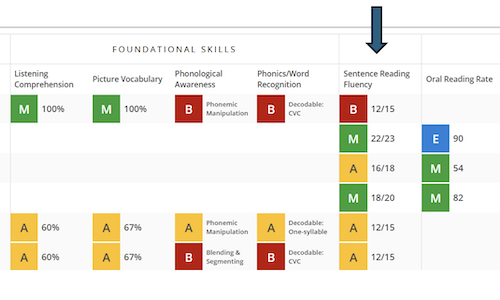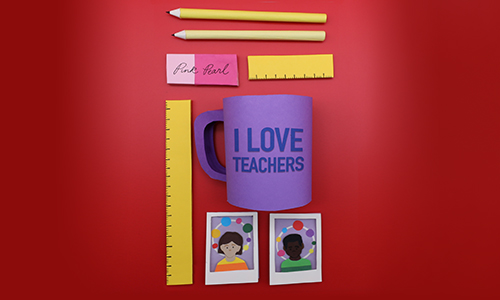If your child takes MAP® Growth™ at school and you’re not sure what it’s for or how it works, we’ve got you covered. Here’s everything you need to know, from what it is to how teachers use it to help your child learn.
MAP Growth defined
MAP Growth is an interim, responsive, computer-based assessment for K–12 students. That’s a really dense definition. Let’s break it down.
- Interim: The test is taken up to three times a year, usually at the start of the school year, halfway through, and near the end. This lets teachers get clear snapshots of how students are doing often and early enough that they can adjust their lesson plans as needed.
- Responsive: Each question on MAP Growth is generated based on the question—and answer—that came right before it. If a student gets it right, the next one is harder. If they get it wrong, the next one’s easier. Students can’t ace the assessment, even if they’re answering questions well beyond their grade level correctly.
- Computer-based: This just means kids take MAP Growth on a computer. Long gone are the days of filling in bubbles on a sheet of paper.
- Assessment: An assessment is a test. MAP Growth is a test, plain and simple. While students don’t get a grade on it, they do get a score, which makes it possible to plot their growth over time, whether that’s a single school year or several years in a row.
Kids can take MAP Growth in math, reading, language usage, and science. Your child’s RIT score reflects how they did on the test. (That acronym stands for Rasch Unit, a concept that gets pretty technical pretty fast. In the mood to geek out? Wikipedia to the rescue!) Your child’s RIT is the number that lets teachers know how much a student knows and how much they are growing academically over time.
MAP Growth is a unique testing experience for kids because they don’t pass or fail. In fact, for teachers to get that accurate measurement of what each kid knows, students will get about half the questions wrong. That doesn’t mean their score doesn’t belong on the fridge (it does) or that cracking open a celebratory pint of ice cream is out of the question (in fact, we strongly recommend it).
How teachers use MAP Growth
There are many ways that teachers across the world use MAP Growth data, but the most popular way to put the data to use is by looking for trends and commonalities in a class of students and then adjust plans to help ensure extra instructional time is spent on the most important learning opportunity areas. For example, a teacher might look at MAP Growth reports and notice that their class has higher than average scores in algebraic thinking but lower than average scores in geometric thinking. This insight enables the teacher to adjust their plans over the next few weeks or even months to spend a little extra time each day on math exercises that build skills in geometric thinking. These kind of strategic shifts in how to allocate classroom instructional time can have a huge impact over the course of a school year, and they have a direct impact on improved learning outcomes for all students.
Get ready for testing
You’re an essential part of your child’s learning support system. To help them get the most out of MAP Growth, here are some things to try—and just one thing to avoid.
- DO read everything your school shares with you about MAP Growth. Your school is the best place to get answers about things like testing days and times, technology issues, and other logistics.
- DO talk to your child’s teacher about what to expect leading up to, on, and after testing day. In most cases, when teachers use data to inform or guide their teaching, they’re using a lot of data from a variety of sources, including from daily classwork and observations. Ask your child’s teacher how MAP Growth data fits in. If they don’t share a Family Report with you at your next conference, ask them for one.
- DO help your child prepare. That’s “prepare,” not “study.” Students shouldn’t study for MAP Growth, but it’s always good to know what to expect. A little confidence building can help nervous test takers feel more at ease, too. Read “Preparing for MAP Growth: 20 tips for families” for more details.
- DO check out our Family Toolkit. Videos, guides, and more will let you dig even deeper with MAP Growth. Our student and family checklist is particularly helpful.
- DO see what it’s like to take MAP Growth. Driver’s ed is great, but nothing beats getting behind the wheel. Try our sample tests and get the same experience your child will (and remember, there is no passing or failing MAP Growth, even if you’re a grown-up).
- DON’T view your child’s RIT score as a grade. Your child’s MAP Growth RIT score isn’t a grade. It’s a single data point that helps their teacher know how much they know and how they are growing academically. It’s there to inform a teacher’s instructional decisions at the class level, not to label or pigeonhole your child.
Lastly, a moment of gratitude
Families have always been central to every student’s MAP Growth journey, so as you’re going through the process with your child—from setting meaningful goals and tracking their progress to celebrating their growth—crack open a pint of ice cream just for yourself. The time, commitment, and love that you put into supporting learning is incredible.
For more on MAP Growth, watch our informational video below.





